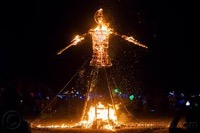Effigy
Origin
Middle French effigie, from Latin effigies, from effingere to form, from ex- + fingere to shape
The word comes, perhaps via French, from the Latin, meaning "representation", and originally was used in English in the plural only – even a single image was "the effigies of ..." The word occurs in Shakespeare's As You Like It of 1600 (II, vii, 193), though it first appeared in 1539. "In effigie" was probably understood as a Latin phrase until the 18th century.
Definitions
• a roughly made model of a particular person, made in order to be damaged or destroyed as a protest or expression of anger: the senator was burned in effigy.
Description
An effigy is a representation of a specific person in the form of sculpture or some other three-dimensional medium. The use of the term is normally restricted to certain contexts in a somewhat arbitrary way: recumbent effigies on tombs are so called, but standing statues of individuals, or busts, are usually not. Likenesses of religious figures in sculpture are not normally called effigies. Effigies are common elements of funerary art, especially as a recumbent effigy (in a lying position) in stone or metal placed on a tomb, or a less permanent "funeral effigy", placed on the coffin in a grand funeral, wearing real clothing. Figures, often caricature in style, that are damaged, destroyed or paraded in order to harm the person represented by magical means, or merely to mock or insult them or their memory, are also called effigies.
It is common to burn an effigy of a person ("burn in effigy") as an act of protest.
